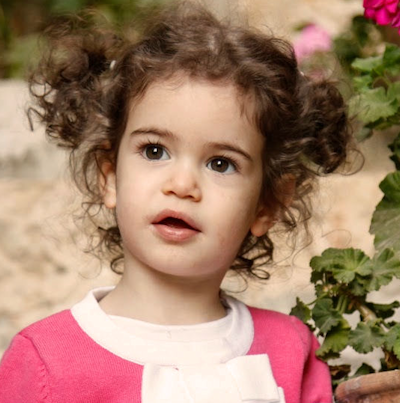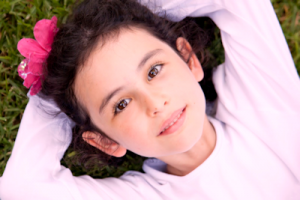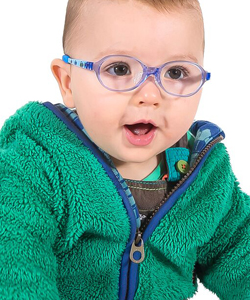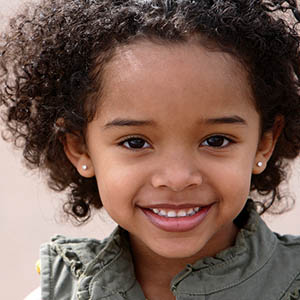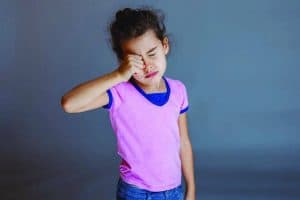The College of Optometrists in Vision Development (COVD), reports that up to 1 in 50 children have esotropia.
A sudden eye turn at ages 2-3 can be very concerning, but might be due to a common and easily treated eye condition, accommodative esotropia.
Esotropia can have a devastating impact on a child’s appearance and self esteem as one eye turns in towards their nose, as well affecting their enjoyment of school and sports.
What is esotropia?
Esotropia is a form of eye turn, when one eye looks ‘cross-eyed’ as it points more inwards (towards the nose) than the other.
The eyes’ ability to stay aligned depends on two things: accommodation (focusing) and convergence.
The focusing system keeps the objects a person is looking at clear and focused. When a person sees an object clearly at a distance, the eye uses less focusing power.
For the eyes to transition from far to near, the muscles in the eyes must change to create the change in the amount of focusing power required.
The convergence system is in charge of aligning the two eyes in space at the same time. When staring at a distant object, the eyes are practically parallel and facing straight ahead.
When a person shifts their gaze from a far away to a near object, their eyes must shift from parallel to slightly inward to avoid double vision. Each time a person looks from distance to near and back again, the eyes must change their convergence to see normally.
These two systems are linked together in the brain, so that when the accommodation increases, so does the convergence, and vice-versa. In most cases, this results in easy, quick changes from distance to near for optimal vision.
However, there can sometimes be a mismatch between the amount of accommodation and the amount of convergence, resulting in too much convergence when the eyes accommodate for near vision.
This causes a condition known as accommodative esotropia, when one eye turns inwards more than the other.
This results in fatigue, double vision, poor reading and other symptoms.
What is accommodative esotropia?
One of the most common forms of esotropia (crossed eye), which is a type of strabismus (eye turn) is accommodative esotropia.
Accommodative esotropia is often first noticed when the child reaches 2-3 years of age.
Accommodative esotropia refers to eye crossing that occurs when the eyes work hard to focus so that they can see clearly. People with accommodative esotropia, also known as refractive esotropia, usually have farsightedness.
What are accommodative esotropia symptoms?
Common symptoms of accommodative esotropia include:
- Amblyopia (lazy eye)
- Eye turn, crossing of the eyes
- Diplopia (double vision)
- Decreased binocular vision (the ability of the eyes to work together)
- Inward turning of the eyes
- Issues with depth perception
- Loss of 3-D vision
People may notice that they cannot focus their eyes on the same place at the same time, and they may only be able to see objects fully with one eye.
If you notice any of the above symptoms in you or your child contact an eye doctor near you.
SEE RELATED: Accommodative Esotropia: Real Patients
Causes and risk factors of accommodative esotropia
While there are no known risk factors for childhood accommodative esotropia, some factors increase the risk of having esotropia, including:
- Family history of strabismus
- Certain medical disorders, such as overactive thyroid and diabetes
- Another eye disorder, such as glaucoma or cataracts
- Neurological conditions, such as excessive fluid in the brain
- Premature birth
- Stroke or brain injury
How is accommodative esotropia treated?
Depending on the severity of accommodative esotropia and the length of time it has been present, will determine the treatment plan.
Vision therapy and eyeglasses can successfully treat all eye turns, including esotropia.
When creating a treatment plan, other considerations include whether there is a misalignment in one or both eyes, and whether or not he esotropia is accommodative.
The goal of treatment always focuses on:
- Eye alignment
- Correcting double vision
- Treating lazy eye
- Reducing vision problems with both eyes
Treatment options include:
Glasses or contact lenses
This is often the first option for treatment. Eye misalignment or farsightedness can be corrected using prescription glasses. If a person’s eyes continue to cross while wearing glasses, a bifocal lens may be required.
Vision therapy
Vision therapy is a customized program that retrains the eyes and brain to work together. It consists of eye exercises, to help strengthen eye function and the muscles around the eye to improve vision.
Vision therapy may also involve a patient wearing a patch over the unaffected eye to improve the function of the crossed eye.
Botox injections
For people who have mild esotropia, botox injections may be used to realign the eyes.
Surgery
In some cases, surgery may be needed to modify the length of the muscles around the eyes; however, this does not necessarily eliminate the need for glasses or contact lenses.
The prognosis for accommodative esotropia depends on its severity and type. While it may resolve on its own, it may require treatment, such as glasses or surgery.
LEARN MORE: Guide to Eye Turns
If you notice your child has an eye turn, schedule an appointment with an eye doctor near you who can help manage and treat your accommodative esotropia, as well as any other underlying conditions.

